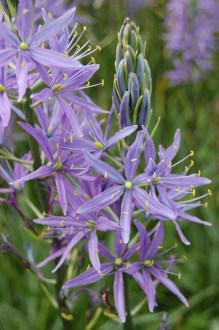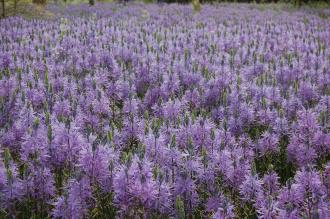
Camassia leichtlinii Flower (05/05/2012, Kew, London)
Position: Sun to partial shade
Flowering period: Late spring to early summer
Soil: Moist, well drained
Eventual Height: 1.2m
Eventual Spread: 0.2m
Hardiness: 5a – 9b
Family: Asparagaceae
Sub Family: Agavoideae
Camassia leichtlinii is an upright bulbous perennial. Its mid green leaves are linear, narrow, channelled, up to 60cm long and basal like. Its purple flowers are star shaped and are composed of 6 petals which vary in color and are up to 10cm across. They appear in racemes on multi flowered stem growing to a height of up to 50cm above the foliage. Its black seeds are ovoid and up to 2mm long.
Camassia leichtlinii, commonly known as Great Camas, Large Camas, Quamash and Quamasia, is native to south west Canada and north west United States. In its native habitat they grow in damp meadows and stream banks.
The etymological root of the binomial name Camassia is derived from Quamash, the N. American Indian name for Camassia esculenta. Leichtlinii is named after Max Leitchlin (1831-1910) a German horticulturist and botanist.

Camassia leichtlinii (05/05/2012, Kew, London)
The landscape architect may find Camassia leichtlinii useful for planting en mass in areas of wild grass, including banks slopes where regular maintenance will not occur, as the stems should be left after flowering. It is also useful in dappled shade locations.
Ecologically, C. leichtlinii is attractive to bees and pollinating insects.
The Royal Horticultural Society has given C. leichtlinii subsp. leichtlinii their prestigious Award of Garden Merit in 1993.
C. leichtlinii prefers moist, fertile, humus rich well-drained soils. It tolerates most pH of soil.
C. leichtlinii requires little maintenance. If naturalised in meadow the leaves should be allowed to naturally die back before cutting the grass.

